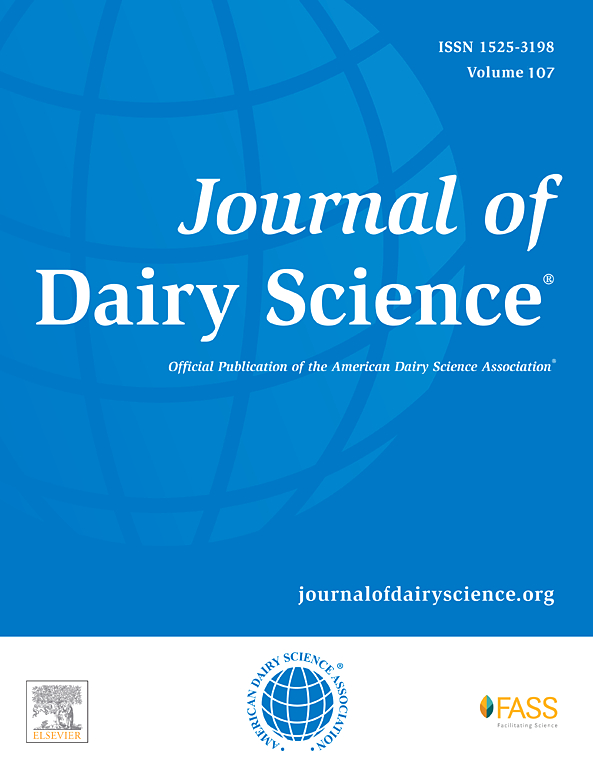动态脉动和乳流量开关点设置对挤奶时间和挤奶后乳状态的影响。
IF 4.4
1区 农林科学
Q1 AGRICULTURE, DAIRY & ANIMAL SCIENCE
引用次数: 0
摘要
本研究的目的是探讨动态脉动设置在奶流量高峰期增加开放相位和减少封闭相位以及增加簇脱离的奶流量开关点对挤奶时间和挤奶后的奶牛状况的影响。本研究填补了目前的知识空白,通过在一个实验中同时告知奶流量开关点和动态脉动的影响,同时提供了挤奶性能、条状奶、乳头状况和挤奶过程中集群真空水平的数据。为此,在4组24头奶牛中进行4个处理,包括不同的奶流量开关点和脉冲器设置组合,持续8周。处理包括2个水平的奶流量开关点(0.2 kg/min和0.8 kg/min)和2个脉冲器设置(静态和动态)。静态脉动器设置的脉动器比例为65:35。对于动态设置,在奶流量为2 kg/min时,脉动器比例为63:37,在奶流量为2 kg/min时,脉动器比例为73:27。采用混合模型对挤奶参数和奶牛评分数据进行分析。乳流量开关点对挤奶时间的影响显著,而动态脉动对挤奶时间的影响不显著。PM挤奶时间的减少幅度更大(对于静态脉动设置,在0.2 kg/min和0.8 kg/min的开关点之间平均减少21%),而AM挤奶时间减少了12%。此外,我们还发现,乳流量开关点为0.8 kg/min(相对于0.2 kg/min)的处理对乳桶堵塞有显著影响,由于显著减少了过度挤奶时间,因此减少了在过度挤奶期间暴露于较高吸口室真空的时间,因此乳桶响的几率降低了。在所有处理中,奶牛平均有32%的挤奶时间高于2公斤/分钟,但这一比例从上午挤奶的37%到下午挤奶的23%不等,因此不均匀的挤奶间隔阻碍了动态脉动的贡献能力,特别是在下午挤奶中。我们得出的结论是,乳流量开关点设置比动态脉动设置对缩短挤奶时间更有影响。此外,我们没有发现开关点和脉冲器设置对挤奶时间、产奶量或奶流率的影响之间存在相互作用的证据。本文章由计算机程序翻译,如有差异,请以英文原文为准。
Effect of dynamic pulsation and milk flow rate switch-point settings on milking duration and postmilking teat condition
The objective of this study was to investigate the effect on milking duration and teat condition after milking with dynamic pulsation settings that increased the open phase and reduced the closed phase of pulsation during the peak milk flow period, together with increasing the milk flow rate switch-point for cluster detachment. The present study filled current gaps in knowledge by informing on the effects of both milk flow rate switch-points and dynamic pulsation together in one experiment, along with presenting data on milking performance, strip milk, teat condition and vacuum levels in the cluster during milking. To this end, 4 treatments consisting of different milk flow rate switch-points and pulsator settings combinations were deployed across 4 groups of 24 cows for 8 weeks. Treatments consisted of 2 levels of milk flow rate switch-point (0.2 kg/min and 0.8 kg/min) and 2 pulsator settings (static and dynamic). The static pulsator settings had a pulsator ratio of 65:35. For the dynamic settings, a pulsator ratio of 63:37 below a milk flow rate of 2 kg/min was used, which changed to 73:27 above 2 kg/min. Milking parameters and teat scoring data were analyzed using mixed models. The effect of milk flow rate switch-point on milking duration was significant, whereas the effect of dynamic pulsation was not. The reductions in milking duration were larger for p.m. milking (for static pulsation settings, the average reduction was 21% between switch-point of 0.2 kg/min and 0.8 kg/min) compared with a 12% reduction for a.m. milking. In addition, we found a significant effect of treatment on teat-barrel congestion, with reduced odds of teat-barrel ringing for treatments with a milk flow rate switch-point of 0.8 kg/min relative to 0.2 kg/min due to significantly reduced over milking time and hence reduced exposure to higher mouthpiece chamber vacuum during the over milking period. On average across all treatments, cows spent 32% of the milking above 2 kg/min, but this varied from 37% for a.m. milking to 23% on average for p.m. milking; hence, an uneven milking interval impeded the ability of dynamic pulsation to contribute, especially for p.m. milking. We concluded that milk flow rate switch-point settings are more impactful than dynamic pulsation settings for reducing milking duration. Furthermore, we found no evidence of interactions between the effects of switch-point and pulsator setting on milking duration, milk yield or milk flow rate.
求助全文
通过发布文献求助,成功后即可免费获取论文全文。
去求助
来源期刊

Journal of Dairy Science
农林科学-奶制品与动物科学
CiteScore
7.90
自引率
17.10%
发文量
784
审稿时长
4.2 months
期刊介绍:
The official journal of the American Dairy Science Association®, Journal of Dairy Science® (JDS) is the leading peer-reviewed general dairy research journal in the world. JDS readers represent education, industry, and government agencies in more than 70 countries with interests in biochemistry, breeding, economics, engineering, environment, food science, genetics, microbiology, nutrition, pathology, physiology, processing, public health, quality assurance, and sanitation.
 求助内容:
求助内容: 应助结果提醒方式:
应助结果提醒方式:


